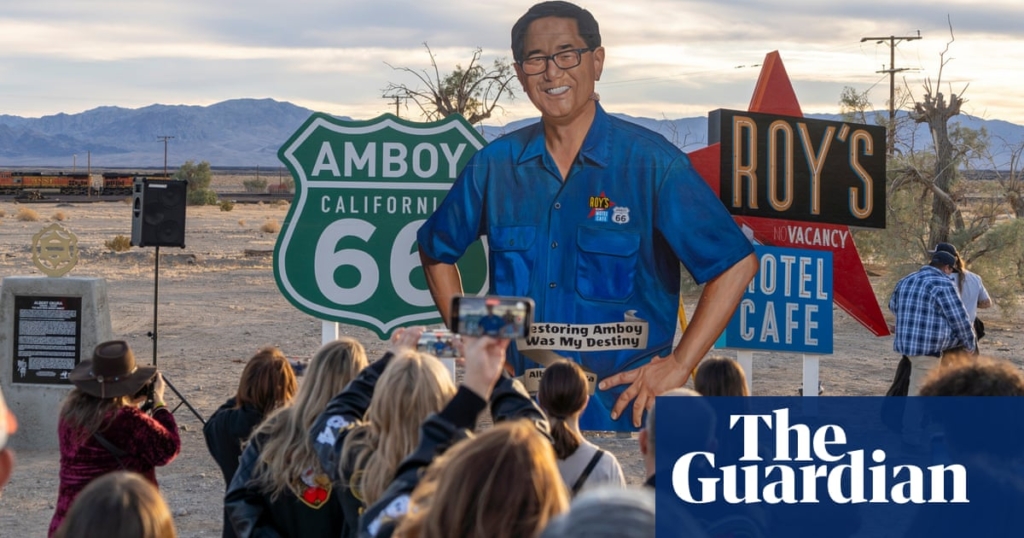Bu içerik, Amboy adlı küçük bir kasabayı ve bu kasabanın geçmişini, Amerikan tarihini ve ailesinin mirasını koruma çabalarını konu ediniyor. Route 66 boyunca yer alan bu kasaba, modern otoyolların yükselişi ve Mojave Çölü’nün zorlu ortamı tarafından mahkum edilmiş gibi görünse de, Amboy’un canlılığını geri kazanmasına yardımcı olan Albert Okura’nın hikayesini anlatıyor. Albert, Juan Pollo adlı Güney Kaliforniya tavuk restoran zincirinin kurucusu olarak tanınan bir adamdır ve Amboy’u satın alarak binalarını yıllarca özenle restore etmiştir. Albert’ın ölümünden sonra, Amboy da Albert’ın mirasını onurlandırmak için bir anıt haline gelmiştir. Bu içerik, Albert’ın ailesinin ve kasabanın geleceğini şekillendirme çabalarını ve Amerikan tarihini koruma tutkusunu vurgulamaktadır. Ayrıca, Amboy’un turistik bir cazibe merkezi haline gelme sürecinde Albert’ın oğlu Kyle Okura’nın liderliğini ve modernleştirme çabalarını ele almaktadır.
[ad 1]
Kaynak: www.theguardian.com
This small town, like so many along Route 66, should be dead. Doomed by the rise of modern highways and the harsh Mojave Desert environment, Amboy should look like its abandoned neighboring towns. Yet, on a crisp November day, Amboy thrummed with friends and travelers swapping stories about the area’s history, the family that saved it, and the road that led them there.
“It’s the mother road,” said Digger Simpson, 61, gesturing towards the legendary Route 66 that once was the nation’s main artery for travel from Chicago to Santa Monica, California. “It’s Americana – it’s mom-and-pop restaurants and gas stations,” he added, reflecting on the nostalgia that drew him from Twentynine Palms to Amboy to celebrate Albert Okura, the man credited with injecting life back into the town.
In 2005, Albert – founder of the southern California chicken restaurant chain Juan Pollo – bought Amboy, a town just under 200 miles east of Los Angeles, and spent years painstakingly restoring its buildings. Before he could fully realize his dream of making Amboy a tourist destination again, Albert died in 2023 at age 71.
Albert’s likeness is now a permanent part of Amboy’s landscape to honor the legacy of the man who spent his life preserving symbols of Americana in part because he was one generation removed from being labeled as un-American.
During the second world war, the US government incarcerated more than 120,000 Japanese Americans citing national security after Japan bombed Pearl Harbor in 1941. Albert’s father Tsuyoshi “Tee” Okura, a second-generation Japanese American, was imprisoned at Jerome, one of the 10 camps the US government built during the war. To prove his Americanness, Albert’s uncle, Susumu Okura, enlisted for the US army from Jerome and died in battle.
Now, a towering 14ft-tall roadside painting depicting Albert is a part of Amboy along Route 66 – two enduring symbols of Americana. At the ceremony, hundreds of families, friends and travelers posed for photos in front of the three-panel artwork and snapped selfies with Albert’s likeness.
The roadside painting is an undeniable pump-your-brakes kind of “visual marker” for tourists to learn about Albert’s story, said John Cerney, 71, the artist. It is also the latest attraction spearheaded by Kyle Okura, Albert’s eldest son, to make Amboy more social-media worthy.
“I see the vision for the future,” said Kyle, 31, who is modernizing Amboy with his millennial sensibilities. His dad once advised him to find unconventional ways to capture public attention for worthy causes. A larger-than-life self-portrait along the US’s most iconic road might not have been Albert’s style.
“But too bad,” said Kyle with a laugh.
‘Out-of-the-way kind of cool’
Once the conduit for westward travel, Route 66 became obsolete in the 1970s when Interstate 40 was completed. Towns like Amboy (peak population 200) which originated in the late 1800s as the first in a series of alphabetically named railroads towns, also withered.
“If it weren’t for Albert, Amboy probably would have succumbed,” said Joe De Kehoe, author and Eastern Mojave Desert historian.
Today, the road itself has become the destination. Drawn by its Old West allure, visitors from around the world still travel the road, said De Kehoe, 83.
For those travelers, Amboy is a pitstop to a bygone era. Roy’s gas and service station, established in 1938 by Roy Crowl and his family, continues to serve travelers with fuel, souvenirs and root beer. The adjacent mid-century modern building that once housed Roy’s Café is now staged to look like the original owners might emerge to hand over keys to one of the motel cottages.
Overnight reservations will have to wait – the cottages are not open for stays yet. But couples still stage wedding photos there.
“It is a cool location,” said Aaron Okura, 30, Kyle’s younger brother. “Just the out-of-the-way kind of cool that makes it appealing on TikTok.”
For a while, revitalizing Amboy was a father-son project. During the long drives from their home in Chino to the desert, Albert and Kyle talked about business strategies and life. Somehow, Kyle said, Albert always steered the conversation back to chicken.
Under his dad’s guidance, Kyle gave Amboy a website and launched its social media presence. He also created nostalgic merchandise and collectibles. In 2019, Kyle helped organize the re-lighting of the Googie-style Roy’s sign – the town’s most photographed landmark, said Sella Okura, Kyle’s mom. At the event, Albert watched with pride as the neon lights reflected in his glasses.
Albert’s sudden death shocked the family, said Sella, but Kyle was especially unmoored. In their father’s absence, the Okura children have taken over leadership positions at Juan Pollo.
Kyle is Amboy’s de facto millennial mayor.
‘Tangible history’
Today, Amboy has one resident – technically 0.5 because Wayne Larson, 63, lives in Roy’s hangar for only for half the year.
Roy’s airport was once public, said Larson, a retired chief of engineering with the National Oceanic and Atmospheric Administration’s marine operations. In the 1950s, Crowl built the hangar for his daughter, Betty, a pilot.
To Larson, Amboy represents a freer time when a businessperson such as Crowl could look out at the desert landscape, dream of an airport, and then build it.
“It’s given us some tangible history,” said Larson, an aviation enthusiast, about the hangar he’s currently renovating.
Roy’s doesn’t fit current regulations to operate as an airport, but planes still use the landing strip – and Larson often helps fix them.
Carly Faulkner, 39, flew into Amboy from Tehachapi on a 1946 Taylorcraft plane with Dustin Mosher, 33, to attend Albert’s artwork unveiling.
“It’s a classic desert destination,” said Faulkner.
Where else but Amboy can visitors arrive by an iconic road or a historic landing strip?
For Albert, Amboy was more than a business venture – it was an enduring tribute to his family’s resilience. It was also a symbol of his patriotism and passion for preserving US history.
But mostly, the town symbolized his dad’s relentless drive for collecting good deals, said Kyle. Albert bought many things in bulk – including reading glasses, which he scattered around the house to his wife’s exasperation. Why would he need 10 pairs of glasses?
In response, Albert always looked at her with a smile and said: “You’ll see.”
Albert often said owning Amboy was his destiny, but he never defined what it looked like or how to operationalize it. In his dad’s absence, Kyle has defined his own vision for Amboy as a more popular filming location (Olivia Rodrigo filmed a music documentary here) and a future music festival venue like a “mini-Coachella”.
In 2026, Route 66 will celebrate its centennial. The Okuras hope to have Amboy’s cafe and motel cottages open by then. To accomplish these goals, mother and son are now collaborating.
Often, Sella thinks about Albert’s prescient words while she accompanies Kyle during the long drives to Amboy. At 61 years old, she now needs reading glasses. She owns about seven pairs that she scatters around the house.
“Now, I can see the vision,” said Sella with a chuckle.
Somewhere, Albert is laughing and saying: “Now, you see.”







Yorumlar kapalı.